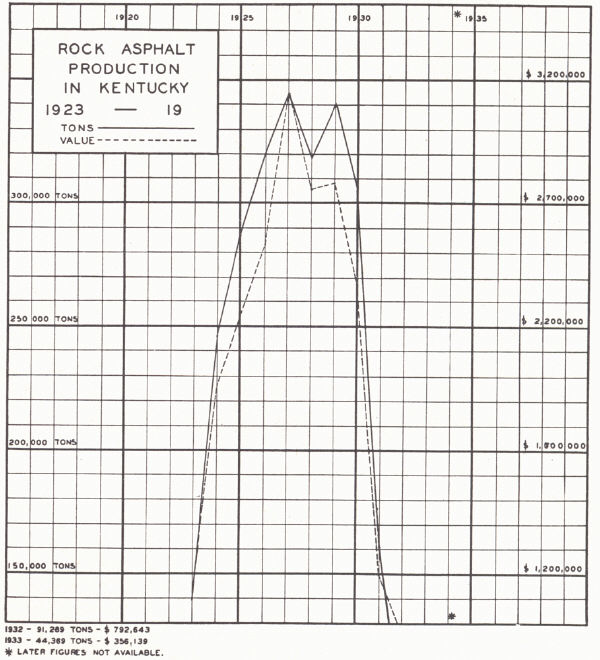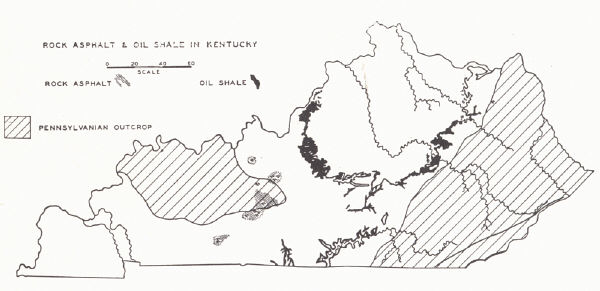

Kentucky rock asphalt is a coarse grained sandstone thoroughly impregnated with bitumen of about the consistency of warm tar. The bitumen content varies from a trace up to complete saturation. Commercial rock is essentially saturated, but because of differences in the original porosity the bitumen varies from 3 or 4 to about 15 per cent. Standard specifications call for 7 per cent. Angularity of grain is also a feature of the better asphalt. Lean rock is used by mixing with the richer to meet specifications, but the artificial mixture is regarded inferior to the natural rock of similar bitumen content.
Rock asphalt deposits of Kentucky have been the most productive until recent years when the lead was taken by Texas. Other producing states (relatively unimportant) include Oklahoma, Alabama, California, and Utah. In Texas the rock is the irregularly impregnated Cretaceous Anacacho limestone. The Alabama production is from the Gasper limestone and the Oklahoma, Utah, and California deposits are bituminous sandstones.1
| PLATE CXIV |
 |
| FIG 1. Rock asphalt production in Kentucky, 1923-1932 |
 |
| FIG. 2. Rock asphalt and oil shale in Kentucky |
Deposits occur in Edmonson, Grayson, Hardin, Breckinridge, Logan, and Warren counties of western Kentucky, with Edmonson County leading and Grayson County second. The deposits of Edmonson County are mainly in the basal sandstone of the Caseyville and the higher Bee Spring sandstone where this member forms the base of the Pottsville. The Cypress and Hardinsburg sandstones are locally impregnated, but because of heavy overburden and location have not been so extensively commercialized. The deposits of Grayson, Breckinridge, and Logan counties are in the Cypress and those of Warren County in the Bee Spring. These formations in western Kentucky are the same as the oil and gas producers in the Owensboro field. An eastern Kentucky deposit near Soldier in Carter County in the basal Pottsville has been worked.
Rock asphalt finds its chief use in the surfacing of streets and highways, also for floors of factories and other industrial plants. It is a competitor of the imported Trinidad asphalt and has a number of advantages:
1. It is laid and repaired without heating.
2. It does not roll and buckle in hot weather.
3. It occurs already mixed in nature, ready to be crushed and laid.
The use of leaner rock mixed with rock exceeding specification in bitumen content makes available considerable reserves of low grade asphalt. It is a high grade paving material, the durability of which depends on the foundation on which it is laid, which varies from crushed limestone to concrete.
In regard to origin, deposits of Kentucky rock asphalt are essentially "defunct" oil pools. The asphalt beds are thus oil sands from which the more volatile hydro-carbons have been lost as a result of exposure of these beds at and near the surface by erosion. Alteration began by circulating ground water while the oil sand was still under cover (Russell, 1933). Exposure to the atmosphere completed the process.
The occurrence of rock asphalt is erratic and lenticular and the mapping of the particular sandstone in which a deposit is known to occur is not a mapping of the asphalt deposit. The whole problem of origin and distribution is that of the origin and distribution of oil and gas pools and the same variable factors involving migration, structure, porosity, and available bituminous matter, all are involved. It is interesting to observe that the known original areal extent of the asphalt region of Edmonson County and vicinity indicates a former oil pool that must have once had available something like 1,000,000,000 barrels of crude oil. This, if present today, would constitute Kentucky's greatest oil field (Russell, 1933).
1 Redfield, Mineral Resources of the United States, Bureau of Mines, 1930.